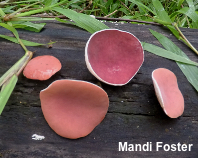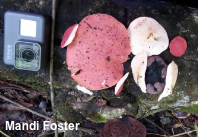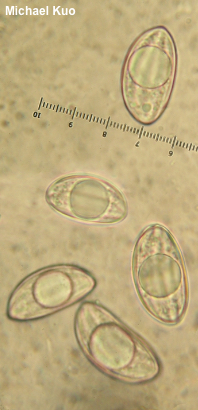| Major Groups > Cup Fungi > Phillipsia domingensis |

|
Phillipsia domingensis [ Ascomycota > Pezizales > Sarcoscyphaceae > Phillipsia . . . ] by Michael Kuo You would think that a big, red, tropical cup fungus would be easy to identify, but there are actually several mushrooms meeting this description. Although an experienced tropical collector probably reaches a familiarity point at which Phillipsia domingensis can be recognized at sight, the rest of us had probably better take a peek under a microscope, where we will find large, widely fusiform spores that have about 6–8 wide striations running from end to end (3–4 of which can be seen at once). Several "lineages" within the Phillipsia domingensis species complex have been noted (Hansen and collaborators 1999), but DNA-based mycology has yet to break up the complex, and the species is still widely defined as pan-tropical. Thorough study of many well-documented collections from diverse areas is needed. Thanks to Mandi Foster for documenting, collecting, and preserving Phillipsia domingensis for study; her collection is deposited in The Herbarium of Michael Kuo. Thanks to Beatriz Ortiz-Santana for sequencing the collection. Description: Ecology: Saprobic on the well-decayed wood of hardwoods; growing alone or gregariously; appearing year-round; originally described from the Dominican Republic; widespread in the Caribbean, Central America, and South America; in North America distributed along the Gulf Coast from Florida to the Yucatán Peninsula; also reported from Oceania, Asia, and southern Africa. The illustrated and described collection is from Florida. Fruiting Body: Disc-shaped to cup-shaped; 2 to 9 cm across; upper surface bright red, fading with age to pinkish red, bald, becoming vaguely and shallowly wrinkled in places with maturity; undersurface whitish, bald or very finely fuzzy; stem absent, or vaguely defined and rudimentary; flesh whitish, not changing when sliced. Odor: Not distinctive. Microscopic Features: Spores 25–31 x 13–16 µm; asymmetrically subfusiform, with one side usually more convex than the other; lined lengthwise with 6–8 wide striations (3–4 visible at once); usually biguttulate; thick-walled; hyaline in water and in KOH; often germinating and developing projections. Asci 8-spored; thick-walled. Paraphyses filiform with subclavate or merely rounded apices; 2–4 µm wide; not or scarcely projecting; smooth; hyaline or with dull red contents. REFERENCES: (M. J. Berkeley, 1852) M. J. Berkeley ex W. C. Denison, 1969. (Seaver, 1942; Denison, 1969; Romero & Gamundi, 1986; Hansen et al., 1999; Zhuang, 2003; Calonge et al., 2006; Angelini & Melardi, 2012; Wang, 2012; Ekanayaka et al., 2017; Ortega-Lopez et al., 2019; Maggio et al., 2021.) Herb. Kuo 08171901. This site contains no information about the edibility or toxicity of mushrooms. |
© MushroomExpert.Com |
|
Cite this page as: Kuo, M. (2021, November). Phillipsia domingensis. Retrieved from the MushroomExpert.Com Web site: http://www.mushroomexpert.com/phillipsia_domingensis.html |



